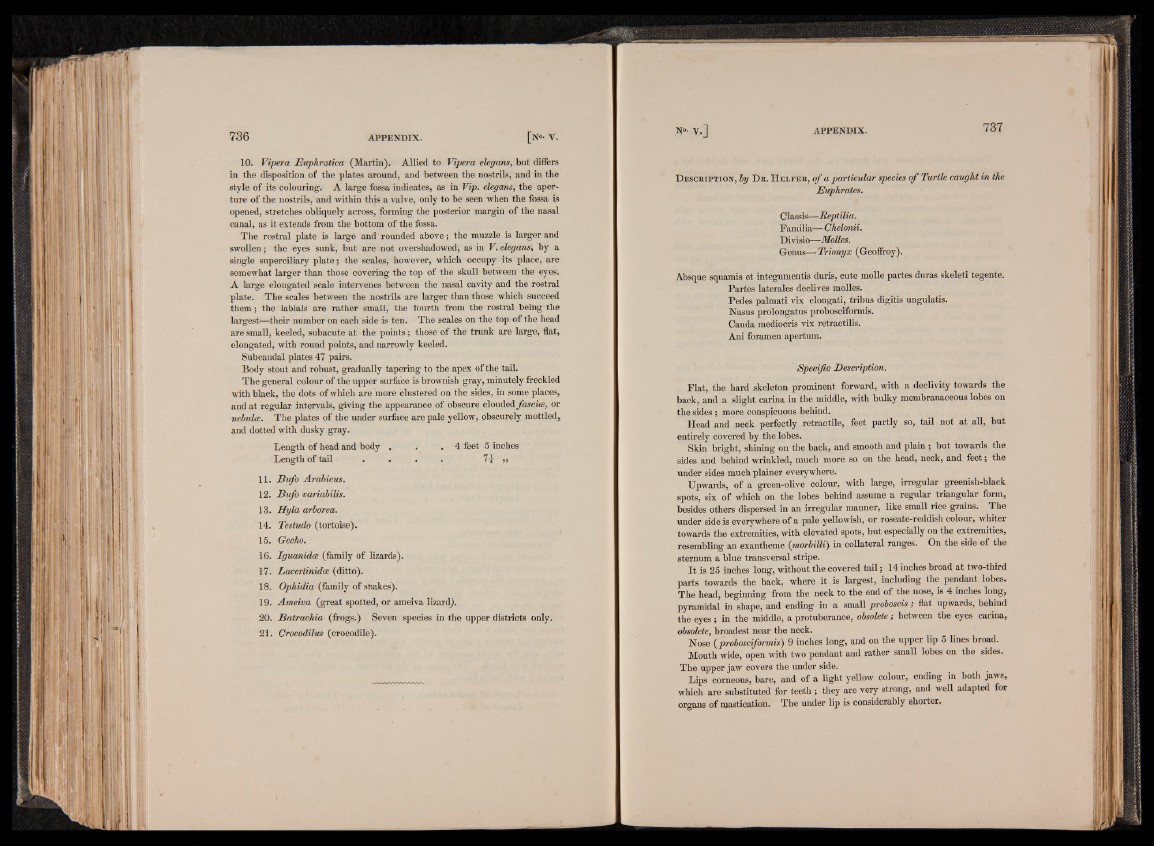
10. Vipera Euphratica (Martin). Allied to Vipera elegans, but differs
in the disposition of the plates around, and between the nostrils, and in the
style of its colouring. A large fossa indicates, as in Vip. elegans, the aperture
of the nostrils, and within this a valve, only to be seen when the fossa is
opened, stretches obliquely across, forming the posterior margin of the nasal
canal, as it extends from the bottom of the fossa.
The rostral plate is large and rounded above; the muzzle is larger and
swollen; the eyes sunk, but are not overshadowed, as in V. elegans, by a
single superciliary p la te ; the scales, however, which occupy its place, are
somewhat larger than those covering the top of the skull between the eyes.
A large elongated scale intervenes between the nasal cavity and the rostral
plate. The scales between the nostrils are larger than those which succeed
them; the labials are rather small, the fourth from the rostral being the
largest—their number on each side is ten. The scales on the top of the head
are small, keeled, subacute at the points; those of the trunk are large, flat,
elongated, with round points, and narrowly keeled.
Subeaudal plates 47 pairs.
Body stout and robust, gradually tapering to the apex of the tail.
The general colour of the upper surface is brownish gray, minutely freckled
with black, the dots of which are more clustered on the sides, in some places,
and at regular intervals, giving the appearance of obscure clouded fascia, or
nebulm. The plates of the under surface are pale yellow, obscurely mottled,
and dotted with dusky gray.
Length of head and body . . . 4 feet 5 inches
Length of tail . . . . 7-|- ,,
11. Bufo Arabieus.
12. Bufo variabilis.
13. Hyla arborea.
14. Testudo (tortoise).
15. Gecko.
16. Iguanidce (family of lizards).
17. Lacertinidce (ditto).
18. Ophidia (family of snakes).
19. Ameiva (great spotted, or ameiva lizard).
20. Batrachia (frogs.) Seven species in the upper districts only.
21. Crocodilus (crocodile).
D e s c r i p t i o n , by D r . H e l p e r , o f a particular species o f Turtle caught in the
Euphrates.
Classis—Eeptilia.
Familia— Chelonii.
Divisio—Molles.
Genus— Trionyx (Geoffroy).
Absque squamis et integumentis duris, cute molle partes duras skeleti tegente.
Partes laterales declives molles.
Pedes palmati vix elongati, tribus digitis ungulatis.
Nasus prolongatus probosciformis.
Cauda mediocris vix retractilis.
Ani foramen apertum.
Specific Description.
Flat, the hard skeleton prominent forward, with a declivity towards the
back, and a slight carina in the middle, with bulky membranaceous lobes on
the sides ; more conspicuous behind.
Head and neck perfectly retractile, feet partly so, tail not at all, but
entirely covered by the lobes.
Skin bright, shining on the back, and smooth and plain ; but towards the
sides and behind wrinkled, much more so on the head, neck, and feet; the
under sides much plainer everywhere.
Upwards, of a green-olive colour, with large, irregular greenish-black
spots, six of which on the lobes behind assume a regular triangular form,
besides others dispersed in an irregular manner, like small rice grains. The
under side is everywhere of a pale yellowish, or roseate-reddish colour, whiter
towards the extremities, with elevated spots, but especially on the extremities,
resembling an exantheme (morbilli) in collateral ranges. On the side of the
sternum a blue transversal stripe.
I t is 25 inches long, without the covered ta il; 14 inches broad at two-third
parts towards the back, where it is largest, including the pendant lobes.
The head, beginning from the neck to the end of the nose, is 4 inches long,
pyramidal in shape, and ending in a small proboscis; flat upwards, behind
the eyes ; in the middle, a protuberance, obsolete; between the eyes carina,
obsolete, broadest near the neck.
Nose ( probosciformis) 9 inches long, and on the upper lip 5 lines broad.
Mouth wide, open with two pendant and rather small lobes on the sides.
The upper jaw covers the under side.
Lips corneous, bare, and of a light yellow colour, ending in both jaws,
which are substituted for teeth ; they are very strong, and well adapted for
organs of mastication. The under lip is considerably shorter.